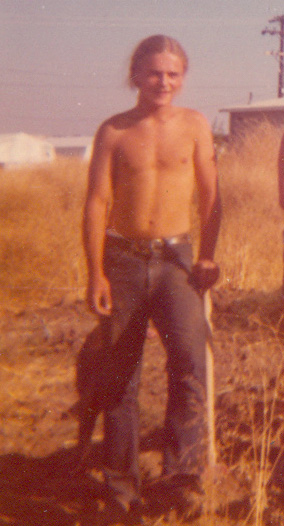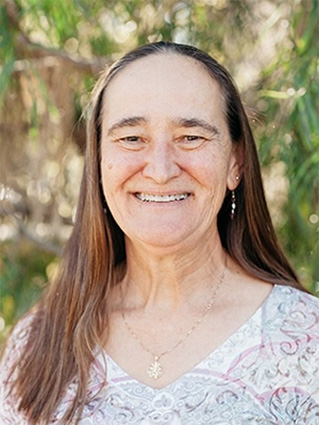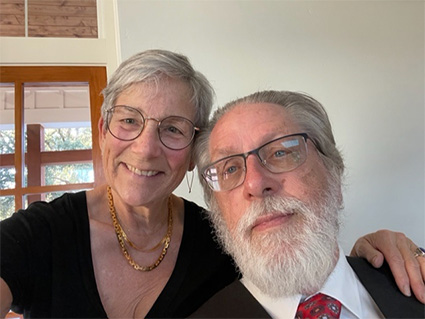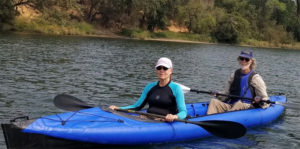
Susan Nelson-Kluk & MIke Kluk
Mike and I were both part of the original 28 students who built the domes in the summer of 1972. I worked on the core unit and drawing some of the plans. Mike dug ditches for the utilities, helped build the mold, helped pull the parts from the mold, and did a lot of concrete work for the floors.
I left at the end of winter quarter 1973 to join a Peace Corps training program in New York but got very homesick for California and decided not to go to Africa to teach science and math in French. After finishing a bachelor’s degree at SUNY Brockport I returned and got a job as a plant pathology technician for a vegetable seed company in Woodland. After 3 years I moved on to a job as a staff research associate at the UC Davis College of Ag. My job included grant writing and working as the liaison between my department and UCD Architects and Engineers during the construction of the National Germplasm Repository and the National Grapevine Importation and Clean Stock Facility. I was able to go to graduate school while working for the university and after only 15 years earnedan MS degree in plant physiology from UCD.
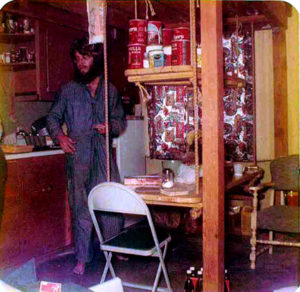 Mike left the domes in 1974 after finishing his bachelor’s degree. His first job was managing a shelter workshop for people with physical and mental disabilities in Woodland. Thenhe spent a year earning a teaching certificate at the OregonCollege of Education in Monmouth Oregon followed by 2 years with Mennonite Voluntary Service in Kansas where he taught in a day care center and private school and started a residential training program for disabled adults. He returned to California in 1978 to attend law school at Golden Gate and Martin Luther King law schools. I finally talked Mike into marrying me in 1979 when law school stress lowered his never-getting-married defenses. We lived in Davis near my work on the University farm from 1979 to 2008. Part of that time we lived in Village Homes, the solar community inspired by the dome project.
Mike left the domes in 1974 after finishing his bachelor’s degree. His first job was managing a shelter workshop for people with physical and mental disabilities in Woodland. Thenhe spent a year earning a teaching certificate at the OregonCollege of Education in Monmouth Oregon followed by 2 years with Mennonite Voluntary Service in Kansas where he taught in a day care center and private school and started a residential training program for disabled adults. He returned to California in 1978 to attend law school at Golden Gate and Martin Luther King law schools. I finally talked Mike into marrying me in 1979 when law school stress lowered his never-getting-married defenses. We lived in Davis near my work on the University farm from 1979 to 2008. Part of that time we lived in Village Homes, the solar community inspired by the dome project.
Mike worked as an attorney for a federally funded organization, Protection and Advocacy, representing people with disabilities in administrative proceedings and state and federal court for 30 years.
Our daughters, Sonya and Amanda, were born in 1982 and 1985. Life was very busy. By 1994 I was burning out at work and so started doing yoga teacher trainings at ashrams in Grass Valley, CA and Val Morin, Quebec to deal with the stress. From 1995 to 2015 I taught Yoga for Sacramento City College, UCD staff development, local health clubs and the Sivananda Ashram Yoga Farm. I kept my job at UC Davis until 2008 when Mike and I both retired and moved to an off-grid 20 acre homestead next door to the Sivananda Ashram in Grass Valley. Michael always planted big vegetable gardens wherever we lived and in Grass Valley he outdid himself with an acre in vegetables, a fruit tree orchard, table grape vineyard and berry patch. He also built a 30’ X 40’ barn, 200 square foot cabin, 2 greenhouses, a wood shed, big chicken coop, duck house two solar arrays and a solar powered irrigation system. We had help from many interesting people from all over the world who stayed with us as part of the World Wide Opportunities on Organic Farms (WWOOF) organization. We gave people room and board in exchange for 20 hours of work a week and organic farming lessons. I harvested food, cooked for everyone, and taught yoga next door at the Yoga Farm. Together Mike and I taught “simple living”and Permaculture classes for guests at the Yoga Farm. It was a very idyllic life except for being a half hour from the nearest store, ever increasing fire danger and ultra conservative marijuana growers with guns who also lived in the neighborhood.
In December 2015 we sold the farm and moved back to Davis where Mike has created a mini farm/big garden in the backyard complete with a greenhouse and rain pond but no chickens, ducks or geese. We now enjoy living within easy biking distance to groceries, health clubs, medical services and restaurants.
And we greatly appreciate the friends we have made in this area over the past fifty years. Mike finally has time to go on long bike rides in the country, often with Pat and Clay and kayaking, sometimes with Pat. He also volunteers with the Master Gardener program, writing articles and teaching workshops, writes articles for a local environmental organization, Cool Davis, about how to lighten our environmental footprint and volunteers for Legal Aid. I have an ebike that rides like a motorcycle and makes it fun to go anyplace in town. I have done some volunteer work for the Davis Friends Quaker Meeting and serve on the board of directors for the Yolo Interfaith Immigration Network (YIIN). We have time to regularly visit our daughters, Sonya and 3 grandsons in San Diego and Amanda in Oakland. We also manage to travel to the mountains and coast to go hiking together. I still love cooking the vegetables Mike grows and figuring out how to make delicious vegan meals for family and friends.
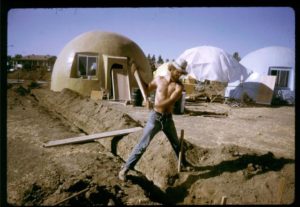
Dome Recollections- Mike Kluk
I don’t remember when I first heard abut the Dome Project. I knew several people from Malcolm Hall and the Tercero Co-op who were interested. Early on there was a meeting, at South Hall probably, that we were expected to attend to be allowed to continue in the project. I had a conflict but Clay put my name on the list of attendees. I was an undocumented domie from the beginning. I’ve always been grateful that Clay signed me in and nobody was checking handwriting. The chance to work towards a shared goal with a really good group of people was a formative experience. Several of my most enduring friendships began or were strengthened through the domes along with, ultimately, marriage to a quite wonderful woman.
My memory of the early stages of the project includes equal parts chaos and innovation. Domes were originally going to be built on an elevated wooden foundation. The time, energy and money required to build the first one pretty much nixed that idea, ending the short history of dome #1. Concrete foundations were the chosen option. For a while after we were on-site, some version of a pvc pipe framework covered with burlap and sprayed with foam and fiberglass was still the plan. A few trials and several errors demonstrated that approach wasn’t going to fly. I suspect that the idea of a giant mold came to Ron after a few too many beers- or something stronger- and Rod Jones and maybe Dave Wheeler helped figure out how it could actually work. The result was, apparently, the largest mold for a fiberglass part built up to that time. Building it set the project timeline back many weeks but the mold did promise to move things along faster once completed- a promise that was only partially realized.

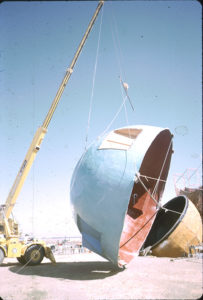
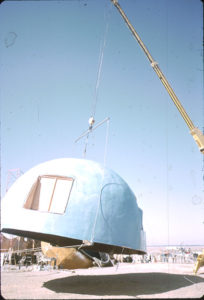
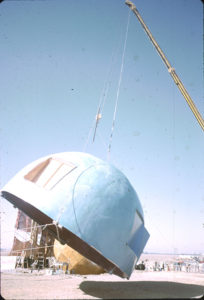
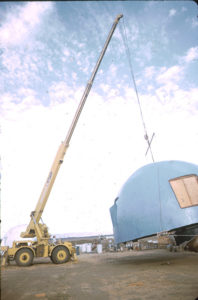

The first dome sprayed in the new mold was also foamed in place. The idea was to pull it out with a crane, set it on a bed of straw and slowly roll it over. The result was a cracked fiberglass shell, crumbling foam and a gloomy future for the project. One of my most notable memories occurred shortly after at Fluffy Donuts. Rod and Ron sat down to figure out a solution. They drew out, on the back of a napkin, the process to rotate the freshly minted dome in the air, using a newly constructed metal frame, set it on the concrete foundation and then spray the foam on the inside. That worked and pretty much saved the project.
Unlike the people who had or acquired more advanced skills such as Dan, Pat and several others, I was a common laborer. I dug ditches, shoveled concrete and helped to pull the parts from the mold. But it was good work and I learned to appreciate the expertise of the professional workers brought into the project. Operating a crane to safely pull a huge, flexible plastic part and turn it over in midair, pouring and finishing a concrete pad when the temperature is approaching 90 and operating a backhoe to dig a ditch on grade, by eye, so that the sewage will flow are difficult tasks that are often under-appreciated.
Clay and my dome, #10, was pulled from the mold near the end of the summer. When classes started, we were basically camping out without power, a bathroom or anything inside except a fairly forlorn looking core unit. Still, we felt fortunate, things were a little tougher for those waiting to live in higher numbered domes. We went across the street to a much-used shared bathroom. A couple of the domes on the east side had run extension cords from the greenhouses across the street. I often found myself in Maryann and Susan’s dome for dinner where they had light and cooked meals in a converted popcorn popper.
When the rain started, and it was wet that year, the puddles began to join into one muddy mess. The extension cords snaking through the water were an OSHA nightmare. But nobody died. It was a very cold winter; the Arab Oil Embargo was still in force and daylight-saving time was extended all year to save power. So, we left for early classes in the chilly dark.
Clay and I managed pretty well with construction of our kitchen, bathroom and loft. We both had journeyman carpentry skills; me because I was always helping my father build something on our small farm on the North Coast and Clay because he had genes handed down from his grandfather who was a shipwright. Clay’s grandfather inspired our table that hung from the underside of our loft with chains. With the shared skills and assistance of the dome community, we managed to pull it off along with everyone else. We salvaged a front door, inscribed it with the name of our new abode, “Palace Flophouse,” and headed into the next two years with a new sense of accomplishment.
It is safe to say that there will never be another student-built housing project like the domes. It was a different time that allowed more risk taking and experimentation. Now the specter of inexperienced students using power tools and climbing ladders inspires fear of liability in the heads of too many administrators. But the lofts still stand and nobody died. We were smart enough to figure most things out and got a little lucky with the rest of it.

